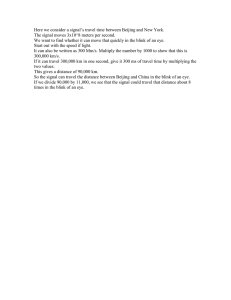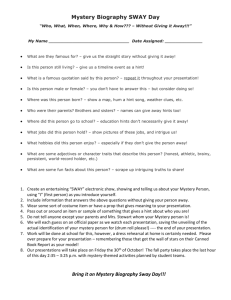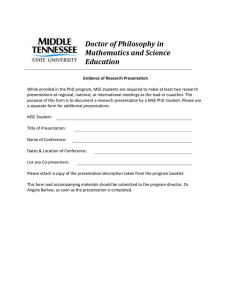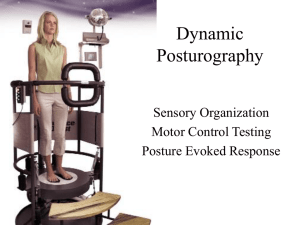Determining, Measuring and Testing Quantitative Signatures of Deception Behaviour D.G. Norman
advertisement
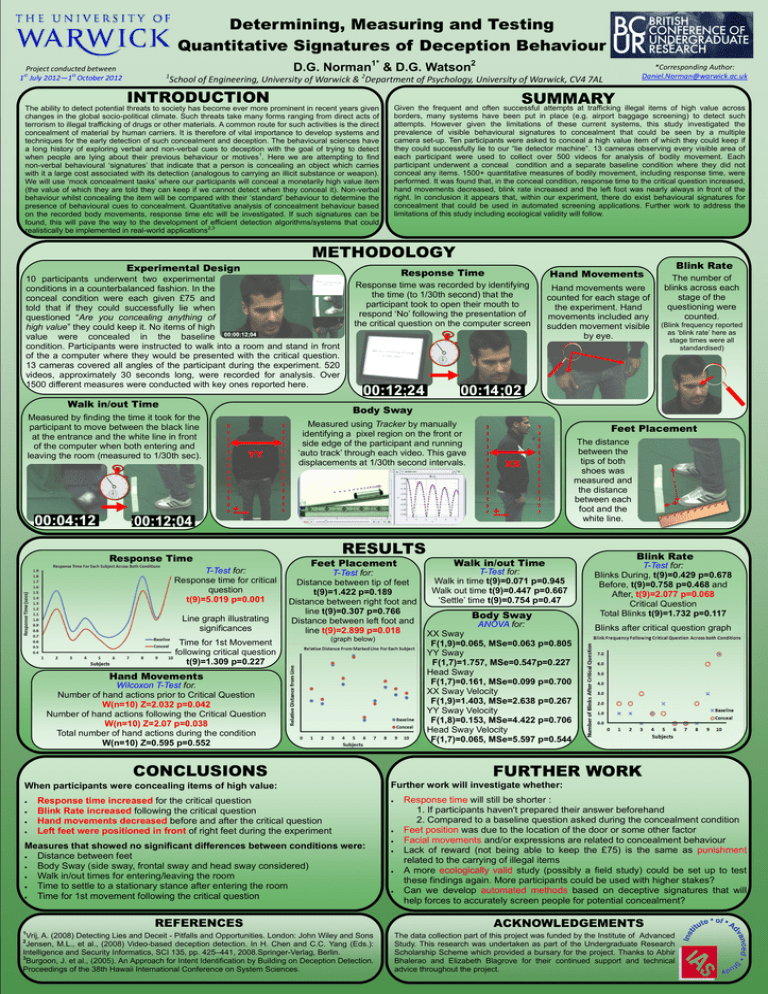
Determining, Measuring and Testing Quantitative Signatures of Deception Behaviour Project conducted between 1st July 2012—1st October 2012 D.G. Norman1* & D.G. Watson2 1 *Corresponding Author: Daniel.Norman@warwick.ac.uk School of Engineering, University of Warwick & 2Department of Psychology, University of Warwick, CV4 7AL INTRODUCTION SUMMARY Given the frequent and often successful attempts at trafficking illegal items of high value across The ability to detect potential threats to society has become ever more prominent in recent years given changes in the global socio-political climate. Such threats take many forms ranging from direct acts of terrorism to illegal trafficking of drugs or other materials. A common route for such activities is the direct concealment of material by human carriers. It is therefore of vital importance to develop systems and techniques for the early detection of such concealment and deception. The behavioural sciences have a long history of exploring verbal and non-verbal cues to deception with the goal of trying to detect when people are lying about their previous behaviour or motives1. Here we are attempting to find non-verbal behavioural ‘signatures’ that indicate that a person is concealing an object which carries with it a large cost associated with its detection (analogous to carrying an illicit substance or weapon). We will use ‘mock concealment tasks’ where our participants will conceal a monetarily high value item (the value of which they are told they can keep if we cannot detect when they conceal it). Non-verbal behaviour whilst concealing the item will be compared with their ‘standard’ behaviour to determine the presence of behavioural cues to concealment. Quantitative analysis of concealment behaviour based on the recorded body movements, response time etc will be investigated. If such signatures can be found, this will pave the way to the development of efficient detection algorithms/systems that could realistically be implemented in real-world applications2,3 borders, many systems have been put in place (e.g. airport baggage screening) to detect such attempts. However given the limitations of these current systems, this study investigated the prevalence of visible behavioural signatures to concealment that could be seen by a multiple camera set-up. Ten participants were asked to conceal a high value item of which they could keep if they could successfully lie to our “lie detector machine”. 13 cameras observing every visible area of each participant were used to collect over 500 videos for analysis of bodily movement. Each participant underwent a conceal condition and a separate baseline condition where they did not conceal any items. 1500+ quantitative measures of bodily movement, including response time, were performed. It was found that, in the conceal condition, response time to the critical question increased, hand movements decreased, blink rate increased and the left foot was nearly always in front of the right. In conclusion it appears that, within our experiment, there do exist behavioural signatures for concealment that could be used in automated screening applications. Further work to address the limitations of this study including ecological validity will follow. METHODOLOGY Experimental Design 10 participants underwent two experimental conditions in a counterbalanced fashion. In the conceal condition were each given £75 and told that if they could successfully lie when questioned “Are you concealing anything of high value” they could keep it. No items of high value were concealed in the baseline condition. Participants were instructed to walk into a room and stand in front of the a computer where they would be presented with the critical question. 13 cameras covered all angles of the participant during the experiment. 520 videos, approximately 30 seconds long, were recorded for analysis. Over 1500 different measures were conducted with key ones reported here. Walk in/out Time Response Time Hand Movements Response time was recorded by identifying the time (to 1/30th second) that the participant took to open their mouth to respond ‘No’ following the presentation of the critical question on the computer screen Hand movements were counted for each stage of the experiment. Hand movements included any sudden movement visible by eye. YY Measured using Tracker by manually identifying a pixel region on the front or side edge of the participant and running ‘auto track’ through each video. This gave displacements at 1/30th second intervals. + Response Time T-Test for: Response time for critical question t(9)=5.019 p=0.001 Line graph illustrating significances Time for 1st Movement following critical question t(9)=1.309 p=0.227 RESULTS Feet Placement T-Test for: Distance between tip of feet t(9)=1.422 p=0.189 Distance between right foot and line t(9)=0.307 p=0.766 Distance between left foot and line t(9)=2.899 p=0.018 (graph below) Wilcoxon T-Test for. Number of hand actions prior to Critical Question W(n=10) Z=2.032 p=0.042 Number of hand actions following the Critical Question W(n=10) Z=2.07 p=0.038 Total number of hand actions during the condition W(n=10) Z=0.595 p=0.552 CONCLUSIONS When participants were concealing items of high value: Response time increased for the critical question Blink Rate increased following the critical question Hand movements decreased before and after the critical question Left feet were positioned in front of right feet during the experiment Measures that showed no significant differences between conditions were: Distance between feet Body Sway (side sway, frontal sway and head sway considered) Walk in/out times for entering/leaving the room Time to settle to a stationary stance after entering the room Time for 1st movement following the critical question REFERENCES 1 Vrij, A. (2008) Detecting Lies and Deceit - Pitfalls and Opportunities. London: John Wiley and Sons Jensen, M.L., et al., (2008) Video-based deception detection. In H. Chen and C.C. Yang (Eds.): Intelligence and Security Informatics, SCI 135, pp. 425–441, 2008.Springer-Verlag, Berlin. 3 Burgoon, J. et al., (2005). An Approach for Intent Identification by Building on Deception Detection. Proceedings of the 38th Hawaii International Conference on System Sciences. 2 (Blink frequency reported as ‘blink rate’ here as stage times were all standardised) Feet Placement XX + Hand Movements The number of blinks across each stage of the questioning were counted. Body Sway Measured by finding the time it took for the participant to move between the black line at the entrance and the white line in front of the computer when both entering and leaving the room (measured to 1/30th sec). Blink Rate Walk in/out Time T-Test for: Walk in time t(9)=0.071 p=0.945 Walk out time t(9)=0.447 p=0.667 ‘Settle’ time t(9)=0.754 p=0.47 Body Sway ANOVA for: XX Sway F(1,9)=0.065, MSe=0.063 p=0.805 YY Sway F(1,7)=1.757, MSe=0.547p=0.227 Head Sway F(1,7)=0.161, MSe=0.099 p=0.700 XX Sway Velocity F(1,9)=1.403, MSe=2.638 p=0.267 YY Sway Velocity F(1,8)=0.153, MSe=4.422 p=0.706 Head Sway Velocity F(1,7)=0.065, MSe=5.597 p=0.544 The distance between the tips of both shoes was measured and the distance between each foot and the white line. Blink Rate T-Test for: Blinks During, t(9)=0.429 p=0.678 Before, t(9)=0.758 p=0.468 and After, t(9)=2.077 p=0.068 Critical Question Total Blinks t(9)=1.732 p=0.117 Blinks after critical question graph FURTHER WORK Further work will investigate whether: Response time will still be shorter : 1. If participants haven't prepared their answer beforehand 2. Compared to a baseline question asked during the concealment condition Feet position was due to the location of the door or some other factor Facial movements and/or expressions are related to concealment behaviour Lack of reward (not being able to keep the £75) is the same as punishment related to the carrying of illegal items A more ecologically valid study (possibly a field study) could be set up to test these findings again. More participants could be used with higher stakes? Can we develop automated methods based on deceptive signatures that will help forces to accurately screen people for potential concealment? ACKNOWLEDGEMENTS The data collection part of this project was funded by the Institute of Advanced Study. This research was undertaken as part of the Undergraduate Research Scholarship Scheme which provided a bursary for the project. Thanks to Abhir Bhalerao and Elizabeth Blagrove for their continued support and technical advice throughout the project.
